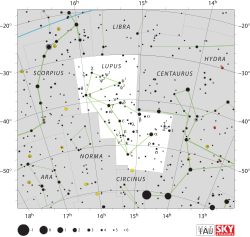Alpha Lupi
| Observation data Epoch J2000 Equinox J2000 | |
|---|---|
| Constellation | Lupus |
| Right ascension | 14h 41m 55.75579s[1] |
| Declination | –47° 23′ 17.5155″[1] |
| Apparent magnitude (V) | 2.30[2] |
| Characteristics | |
| Spectral type | B1.5 III[3] |
| U−B color index | –0.88[2] |
| B−V color index | –0.20[2] |
| Variable type | Beta Cephei |
| Astrometry | |
| Radial velocity (Rv) | +5.4 ± 0.6[4] km/s |
| Proper motion (μ) | RA: −20.94[1] mas/yr Dec.: −23.67[1] mas/yr |
| Parallax (π) | 7.02 ± 0.17 mas[1] |
| Distance | 460 ± 10 ly (142 ± 3 pc) |
| Absolute magnitude (MV) | −4.3[5] |
| Details | |
| Mass | 10.1 ± 1.0[6] M☉ |
| Luminosity | 25,000[5] L☉ |
| Surface gravity (log g) | 3.46[5] cgs |
| Temperature | 21,820 ± 2,160[7] K |
| Metallicity [Fe/H] | 0.04[8] dex |
| Rotational velocity (v sin i) | 16[4] km/s |
| Age | 16–20[4] Myr |
| Other designations | |
Alpha Lupi (α Lupi, α Lup) is the brightest star in the southern constellation of Lupus. According to the Bortle Dark-Sky Scale, the apparent visual magnitude of 2.3[2] makes it readily visible to the naked eye. Based upon parallax measurements made during the Hipparcos mission,[10] the star is located at a distance of around 460 light-years (140 parsecs) from Earth.[1]
Alpha Lupi is a giant star with a stellar classification of B1.5 III.[3] It has about ten times the mass of the Sun[6] but is radiating 25,000[5] times the Sun's luminosity. The outer atmosphere has an effective temperature of 21,820 K,[7] which gives it the blue-white glow of a B-type star. In 1956 it was identified as a Beta Cephei variable,[11] which means it undergoes periodic changes in luminosity because of pulsations in the atmosphere. The variability period is 0.29585 days,[8] or just over 7 hours, 6 minutes. The magnitude varies by about 0.03, or about 3% of the total luminosity. A small star situated near Alpha Lupi may just be an optical companion.
This star is a proper motion member of the Upper-Centaurus Lupus sub-group in the Scorpius-Centaurus OB association, the nearest such co-moving association of massive stars to the Sun.[5] This is a gravitationally unbound stellar association with an estimated age of 16–20 million years. The association is also the source of a bubble of hot gas that contains the Sun, known as the Local Bubble.[4]
Etymology
In Chinese, 騎官 (Qí Guān), meaning Imperial Guards, refers to an asterism consisting of α Lupi, γ Lupi, δ Lupi, κ Centauri, β Lupi, λ Lupi, ε Lupi, μ Lup, π Lupi and ο Lupi .[12] Consequently, α Lupi itself is known as 騎官十 (Qí Guān shí, English: the Tenth Star of Imperial Guards.).[13]
R. H. Allen had opinion that this star was listed it in the Chinese asterism Yang Mun or Men(南門), meaning "the South Gate", in his work Star-Names and their Meanings.[14] But in Chinese astronomy, 南門 is located in Horn mansion and consisted by α and ε Centauri. Yang Mun was translated in Pinyin as 陽門, meaning "the Yang Gate", refers to the asterism in Neck mansion, containing the stars in Centaurus.[15] Allen also suggested that the Babylonian name for the star was "Kakkab Su-gub Gud-Elim" (Star Left Hand of the Horned Bull).[14]
References
- ^ a b c d e f van Leeuwen, F. (November 2007). "Validation of the new Hipparcos reduction". Astronomy and Astrophysics. 474 (2): 653–664. arXiv:0708.1752. Bibcode:2007A&A...474..653V. doi:10.1051/0004-6361:20078357.
- ^ a b c d Johnson, H. L.; et al. (1966), "UBVRIJKL photometry of the bright stars", Communications of the Lunar and Planetary Laboratory, 4 (99), Bibcode:1966CoLPL...4...99J
- ^ a b Hiltner, W. A.; Garrison, R. F.; Schild, R. E. (July 1969), "MK Spectral Types for Bright Southern OB Stars", Astrophysical Journal, 157: 313–326, Bibcode:1969ApJ...157..313H, doi:10.1086/150069
- ^ a b c d Jilinski, E. (March 2006), "Radial velocity measurements of B stars in the Scorpius-Centaurus association", Astronomy and Astrophysics, 448 (3): 1001–1006, arXiv:astro-ph/0601643, Bibcode:2006A&A...448.1001J, doi:10.1051/0004-6361:20041614
{{citation}}: Unknown parameter|coauthors=ignored (|author=suggested) (help) - ^ a b c d e de Geus, P. T.; de Zeeuw; Lub, J. (June 1989), "Physical parameters of stars in the Scorpio-Centaurus OB association", Astronomy and Astrophysics, 216 (1–2): 44–61, Bibcode:1989A&A...216...44D
- ^ a b Tetzlaff, N.; Neuhäuser, R.; Hohle, M. M. (january 2011), "A catalogue of young runaway Hipparcos stars within 3 kpc from the Sun", Monthly Notices of the Royal Astronomical Society, 410 (1): 190–200, arXiv:1007.4883, Bibcode:2011MNRAS.410..190T, doi:10.1111/j.1365-2966.2010.17434.x
{{citation}}: Check date values in:|date=(help)CS1 maint: unflagged free DOI (link) - ^ a b Sokolov, N. A. (May 1995), "The determination of T_eff_ of B, A and F main sequence stars from the continuum between 3200 A and 3600 A", Astronomy and Astrophysics Supplement, 110: 553–564, Bibcode:1995A&AS..110..553S
- ^ a b Daszyńska-Daszkiewicz, J.; Niemczura, E. (April 2005), "Metallicity of mono- and multiperiodic β Cephei stars", Astronomy and Astrophysics, 433 (3): 1031–1035, arXiv:astro-ph/0410442, Bibcode:2005A&A...433.1031D, doi:10.1051/0004-6361:20040397
- ^ "V* alf Lup -- Variable Star of beta Cep type", SIMBAD, Centre de Données astronomiques de Strasbourg, retrieved 2009-10-26
- ^ Perryman, M. A. C.; et al. (April 1997), "The HIPPARCOS Catalogue", Astronomy & Astrophysics, 323: L49–L52, Bibcode:1997A&A...323L..49P
- ^ Pagel, B. E. J. (1956), "Results of a search for bright β Cephei variables in the southern sky", Monthly Notices of the Royal Astronomical Society, 116: 10–24, Bibcode:1956MNRAS.116...10P
- ^ Template:Zh icon 中國星座神話, written by 陳久金. Published by 台灣書房出版有限公司, 2005, ISBN 978-986-7332-25-7.
- ^ Template:Zh icon 香港太空館 - 研究資源 - 亮星中英對照表, Hong Kong Space Museum. Accessed on line November 23, 2010.]
- ^ a b Allen, R. H. (1963). Star Names: Their Lore and Meaning (Reprint ed.). New York, NY: Dover Publications Inc. p. 279. ISBN 0-486-21079-0.
- ^ Allen transliterated 南門 as Nan Mun in Centaurus.
Allen, R. H. (1963). Star Names: Their Lore and Meaning. p. 153.

